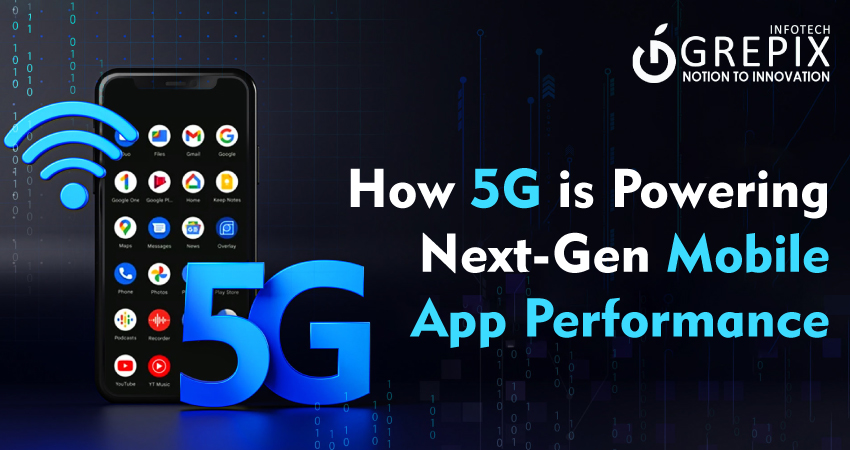How 5G is Powering Next-Gen Mobile App Performance
In 2025, 5G mobile apps are no longer futuristic they’re mainstream. The rollout of 5G networks across the globe is transforming not just how we connect, but how mobile applications are built, delivered, and experienced.
For over a decade, 4G powered the mobile revolution. It enabled social media platforms, ride-hailing apps, video streaming, and the first wave of mobile commerce. But as user expectations evolved—demanding zero-lag gaming, immersive AR/VR, real-time healthcare, and smart city services 4G started hitting its limits.
This is where 5G mobile apps step in. Offering 10x faster speeds, ultra-low latency, and unprecedented device connectivity, 5G is the backbone of next-gen app performance in 2025. The shift from 4G to 5G is not just evolutionary—it’s revolutionary, opening doors to 5G-enabled applications that can support billions of devices, real-time analytics, and experiences once thought impossible.
The rollout of 5G in 2025 is redefining the world of mobile apps. With ultra-low latency, gigabit speeds, and massive device connectivity, 5G unlocks seamless streaming, immersive AR/VR, AI-powered personalization, and real-time healthcare. Frameworks like Flutter, React Native, and Unity empower developers to create 5G-enabled applications optimized for performance and scalability. While challenges like cost, device compatibility, and privacy remain, the opportunities outweigh the risks. Businesses investing in mobile app development today can leverage 5G to stay competitive, deliver superior user experiences, and lead in an era where app performance 2025 is the ultimate benchmark.
Key Features of 5G That Transform Mobile Apps
Ultra-Low Latency: The Real-Time Enabler
With latency as low as 1 millisecond, 5G allows data to move nearly instantaneously. For mobile apps, this means:
- Real-time multiplayer gaming with no lag.
- Telemedicine apps where a doctor can interact with patients as if face-to-face.
- Remote machinery control in industries like mining or manufacturing.
Blazing Fast Speeds: Gigabit-Level Downloads
5G networks deliver speeds up to 10 Gbps, nearly 100x faster than 4G. This allows:
- 4K/8K streaming in mobile apps without buffering.
- Massive file transfers for remote work and collaboration apps.
- Faster loading times, boosting app performance 2025 benchmarks.
Massive Device Connectivity
Unlike 4G, 5G can handle 1 million devices per square kilometer. This makes it the foundation of the IoT ecosystem powering:
- Smart cities with connected infrastructure.
- Healthcare devices transmitting patient data in real-time.
- Wearables syncing continuously without delays.
Enhanced Network Reliability & Coverage
5G ensures stable performance in crowded stadiums, concerts, or remote villages, enabling developers to design 5G-enabled applications that remain reliable under any condition.
How 5G Elevates Mobile App Performance
Seamless Streaming & Cloud Gaming
In the 4G era, high-quality streaming meant buffering. In 5G, apps like Netflix, YouTube, and Twitch now deliver lag-free streaming.
Cloud gaming Google Stadia, Xbox Cloud Gaming, NVIDIA GeForce Now once struggled with latency. With 5G:
- Gamers enjoy console-quality play on smartphones.
- Developers can create cross-device gaming ecosystems.
- Multiplayer apps achieve millisecond synchronization, redefining user experience.
Augmented Reality (AR) & Virtual Reality (VR)
5G makes immersive, real-time AR/VR apps possible.
- Retail apps: Ikea’s AR shopping lets customers place furniture virtually.
- Education apps: VR simulations allow students to explore history or science.
- Navigation apps: Real-time AR overlays guide pedestrians through complex cities.
These experiences are bandwidth-heavy, and only 5G’s ultra-speed can deliver them seamlessly.
AI-Powered Experiences
AI thrives on real-time data processing. With 5G, apps can:
- Translate conversations instantly in multiple languages.
- Offer hyper-personalized recommendations in e-commerce.
- Use predictive analytics for ride-hailing and logistics apps.
The fusion of 5G + AI in app development is setting new standards for performance.
IoT & Smart Devices
From smart homes to connected cars, IoT devices rely on 5G for consistent connectivity.
- Smart thermostats adjust in real time.
- Wearables track vitals continuously.
- Vehicles communicate with traffic signals for safer commutes.
This creates demand for 5G-enabled applications that integrate multiple devices into one seamless experience.
Mobile Commerce & FinTech
Mobile commerce is exploding in 2025, and 5G mobile apps are leading the charge.
- Instant checkout with biometric verification.
- Faster, safer online transactions.
- Fraud detection powered by AI models analyzing live transaction streams.
This improves both user trust and conversion rates for e-commerce and fintech businesses.
Healthcare & Remote Monitoring
In healthcare, 5G is a lifesaver literally.
- Real-time telemedicine consultations without video lag.
- Surgeons operating robots remotely via ultra-low latency.
- Mobile health apps transmitting vitals for chronic patients.
These 5G-enabled applications enhance accessibility and reliability in healthcare like never before.
Smart Cities & Edge Computing
Smart cities thrive on data and 5G fuels that ecosystem.
- Real-time traffic monitoring reduces congestion.
- Smart energy grids improve sustainability.
- Public safety apps detect hazards instantly.
With edge computing, apps can process data closer to users, ensuring lightning-fast decisions.
Best Frameworks & Tools Leveraging 5G in 2025
Developers need the right tools to create 5G mobile apps. In 2025, these frameworks dominate:
Flutter 3.16+
- Cross-platform support for Android, iOS, and web.
- Built-in network optimizations for 5G app performance.
- Smooth rendering for real-time, data-heavy applications.
React Native + Expo
- JavaScript-powered framework ideal for collaboration apps.
- Optimized to handle real-time 5G data streams.
- Strong ecosystem and rapid updates.
.NET MAUI
- Microsoft’s cross-platform powerhouse for enterprise-grade apps.
- Seamless integration with Azure Edge Zones.
- Excellent for finance, healthcare, and IoT-based 5G-enabled applications.
Unity & Unreal Engine
- AR/VR gaming frameworks pushing 5G app development to the next level.
- Supports real-time rendering for the metaverse and immersive training.
5G-Ready APIs & SDKs
- AWS Wavelength: Edge computing for ultra-low latency apps.
- Azure Edge Zones: Enterprise integration with 5G performance.
- Google Cloud Mobile Edge: Ideal for AR/VR, streaming, and IoT.
Also Read: "Cross-Platform Development: Best Tools & Frameworks for 2025"
Challenges & Considerations
While promising, 5G mobile apps also bring hurdles:
Device Compatibility
Not all smartphones support 5G. Developers must design apps that degrade gracefully on 4G.
Data Privacy & Security
More devices mean more attack surfaces. App development must include advanced encryption, zero-trust frameworks, and compliance with GDPR/CCPA.
Infrastructure Costs
5G adoption is expensive. Startups must balance performance with cost, often opting for cloud partnerships instead of building infrastructure.
Battery Consumption
Constant 5G connectivity drains power faster. Developers need to optimize app performance 2025 with energy-efficient coding practices.
Future Outlook (2025 and Beyond)
The possibilities of 5G-enabled applications extend far beyond 2025.
- Hyper-Personalized Ecosystems: Apps adapt to user behavior in real time.
- Metaverse Integration: Always-connected AR/VR experiences via 5G mobile apps.
- Autonomous Systems: Drones, cars, and industrial robots connected through 5G networks.
- Toward 6G: Researchers predict 6G will introduce holographic communications and even faster speeds, shaping the future of app development.
Conclusion
The rollout of 5G in 2025 is the catalyst for a new era of mobile app development. Businesses and developers now have the power to create 5G mobile apps that deliver real-time responsiveness, immersive AR/VR experiences, secure mobile commerce, and smarter IoT ecosystems.
Yes, challenges remain device compatibility, privacy, and infrastructure costs—but the advantages of 5G-enabled applications far outweigh these barriers. By leveraging modern frameworks like Flutter, React Native, and Unity, developers can optimize app performance 2025 to meet user expectations of speed and intelligence.
The winners of the digital future will be those who act now. Invest in 5G-powered app development today to stay ahead, deliver unmatched user experiences, and thrive in a world defined by seamless connectivity.
FAQs
1. How does 5G improve app performance in 2025?
It reduces latency, boosts speed, and increases reliability, enabling seamless streaming, gaming, and IoT integration.
2. Which industries benefit most from 5G-enabled applications?
Healthcare, gaming, fintech, retail, logistics, and smart cities are leading adopters of 5G mobile apps.
3. Are all smartphones 5G-ready?
No. Only 5G-compatible devices can leverage full benefits, but apps must remain backward-compatible with 4G.
4. What frameworks are best for 5G app development?
Flutter, React Native, .NET MAUI, and Unity are widely used for creating 5G-enabled applications.
5. Does 5G increase app development costs?
Infrastructure costs may rise, but improved performance leads to higher engagement, retention, and ROI.
Launch your vision with our mobile app development company, where innovation meets excellence to create cutting-edge mobile solutions."







